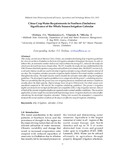Please use this identifier to cite or link to this item:
https://cris.library.msu.ac.zw//handle/11408/461| Title: | Citrus crop water requirements in northern Zimbabwe: significance of the whole season irrigation calendar | Authors: | Zirebwa, Farai S. Mashonjowa, E. Chipindu, B. Mhizha, T. |
Keywords: | Drip irrigation, calendar, Citrus | Issue Date: | 2012 | Publisher: | Midlands State University | Series/Report no.: | Midlands State University Journal of Science, Agriculture and Technology;Vol.3(1) | Abstract: | This study, carried out at Mazowe Citrus Estate, was aimed at developing drip irrigation guidelines for citrus in northern Zimbabwe in the form of irrigation calendars throughout the season. In order to achieve this, an automatic weather station was used to obtain the average ETo values for the study site which were derived from micro climatic data. The ETo trend for the study site was established from the FAO Penman Monteith equation using observed and historical climatic data. BUDGET (version 6.2), a soil water balance model was used to develop irrigation calendars using a fixed irrigation interval of one day. The irrigation calendars presents irrigation depths linked to the actual weather conditions throughout the season. The model was also used to simulate the soil water status after using the irrigation guidelines. The developed irrigation guidelines were compared with the grower's scheduling practise. There is a possibility that the grower was over irrigating based on simulated soil moisture conditions usually above the field capacity. High drainage losses of up to 1964 mm for the whole season were simulated compared to 381 mm for the irrigation scheduling guidelines. The grower s irrigation depths were found to be too high and therefore not compatible with a 1 day irrigation interval. Almost a third of the current irrigation depth was required under normal weather conditions. The excessive application of water might be associated with high drainage losses. Irrigation depth was reduced after considering the developed irrigation calendars. Taking into account the atmosphere's evaporative demand (the actual weather condition of the day) is an effective way of irrigation scheduling. | URI: | http://hdl.handle.net/11408/461 |
| Appears in Collections: | Research Papers |
Files in This Item:
| File | Description | Size | Format | |
|---|---|---|---|---|
| zirebwa.pdf | 1.17 MB | Adobe PDF |  View/Open |
Items in MSUIR are protected by copyright, with all rights reserved, unless otherwise indicated.



